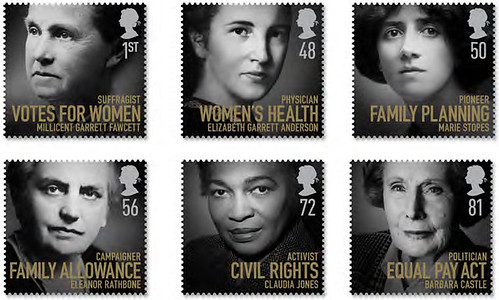 |
| Royal Mail stamp collection |
Six notable women have been honoured these days by the Royal Mail and appear on a series of stamps showing their portraits. They all have two things in common, apart from being women, they have achieved something outstanding, and none of them has received a peerage.
The 48p stamp shows Elizabeth Garrett Anderson (1836-1917). Like her younger sister Millicent Garrett Fawcett, she was determined to surmount gender barriers and decided to become a doctor. At that time, medicine was still an all male preserve, and she was turned down by all medical schools she applied to. She therefore studied privately and became the first woman to gain a medical qualification in Britain. She began working with poor women at what later became London’s New Hospital for women, where she installed the London School of Medicine for Women.
The 50p stamp shows Marie Stopes (1880-1958). She opened the first family planning clinic in London in 1921, and wrote Britain’s first sex manual. She is better remembered as a racist Nazi bigot, who’s view on eugenics not only coincided with the views held in Nazi Germany, but made her a passionate admirer of Hitler sending him a love letter and a book of poems. She campaigned to have the poor, the sick and people of mixed race sterilized. The inclusion of such a person who was an advocate for Nazi eugenics (selective breeding) and a racist to boot is quite incomprehensible.
The 56p stamp shows Eleanor Rathbone (1872-1946). She was one of the first women to win a seat in the Commons. She was the chief campaigner behind the Family Allowances Act in 1945 and crucial to its passing into law. She warned early against Hitler and was militantly anti-Nazi. Somehow the perfect fit with the 50p stamp.
The 72p stamp shows Claudia Jones (1915-1964). Born in Trinidad, she moved with her parents to New York at the age of eight, where they lived in poverty in Harlem. As a Communist and an activist for civil rights, she was one of many political prisoners in the United States and was deported in 1955. Receiving asylum in Britain and after the race riots of 1958, she helped set up Notting Hill Carnival which showcases Afro-Caribbean talent and culture.
The 81p stamp shows Barbara Castle (1910-2002). Secretary in the Wilson government, she was one of the main supporters of the Equal Pay Act of 1970 which prohibits less favourable pay and conditions for women. Her plan to break the power of the unions on the other hand was a mitigated disaster.
The 1£ stamp shows Millicent Garrett Fawcett (1847-1929). As President of the National Union of Women’s Suffrage Society she was a tireless worker for the right for women to vote. Unlike Emmeline Pankhurst who advocated violent confrontation, Millicent Garrett Fawcett preferred a conciliatory approach. It was due to her that women were granted vote in 1918.
Where five of these women might be controversial choices, the Royal Mail has been roundly and universally condemned for the inclusion of the Nazi supporter Marie Stopes. If you are a stamp collector, you should get these stamps early, because with this entire fracas going on it is even possible that the stamp or the series will be put out of circulation.
 RSS Feed
RSS Feed Twitter
Twitter
0 comments:
Post a Comment